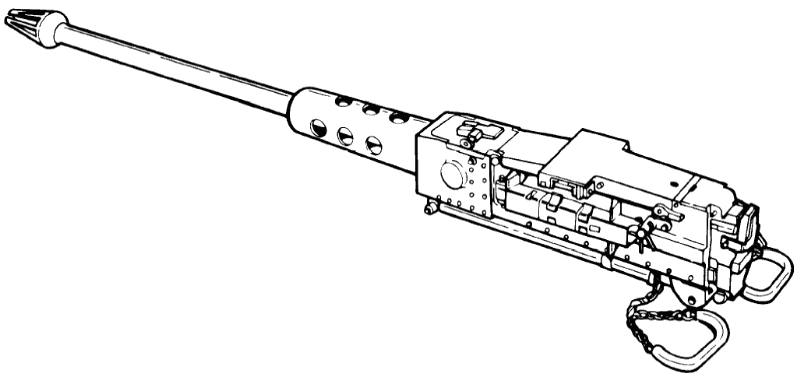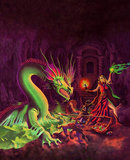|
If anything Lance armed cavalry grew in popularity over the course of the various coalition wars and stayed pretty strong until WWI kicked off. The British reintroduced lancers during the coalition wars, and the French expanded their use greatly, influenced primarily by Poles. After the Franco-Prussian war, all German cavalry units were issued lances regardless of their nominal type. From a doctrine perspective, use of the modern lance would have been quite familiar to a mounted knight. You use the lance in a shock charge, and once it sticks in something/someone in a way that you can't get it out you drop it and draw the sword. Once the situation degenerates in to a furball you go for the sword and pistols. I'm fairly certain you could drop a say, 11th century knight in to a Napoleonic Uhlan regiment and it would all be fairly intuitive. You can also use it to harry infantry and stab them in the back of the head and upper body as they run in front of you, which is safer than trying to lean down and hit them with a sword - you're ~10 feet off of them rather than ~3 feet.
|
|
|
|

|
| # ? Apr 29, 2024 07:14 |
SeanBeansShako posted:Are you talking about after or during? and what nations army? No for sure, I was just thinking that cuirassiers, hussars, dragoons, etc seem to be more sword-based cavalry not lance based. I know there were lancers but they didn't seem as prominent despite that I figured the reach of a lance might still be useful as a primary weapon even before it broke.
|
|
|
|
|
KYOON GRIFFEY JR posted:If anything Lance armed cavalry grew in popularity over the course of the various coalition wars and stayed pretty strong until WWI kicked off. The British reintroduced lancers during the coalition wars, and the French expanded their use greatly, influenced primarily by Poles. After the Franco-Prussian war, all German cavalry units were issued lances regardless of their nominal type. A unit being issued lances is different from a unit having lances as their primary weapon. Not even all of the Napoleonic lancers carried lances in battle, usually only the front rank did.
|
|
|
|
sure, most of the work was done by swords because in an ideal world you get to form up for a shock charge like maybe one or two times per battle, but that doesn't refute the statement that use of lances actually grew during the Napoleonic wars, rather than shrank. the core premise of the OP, that the lance fell out of favor during the Napoleonic wars, is incorrect.
|
|
|
|
LLSix posted:If both of a knight's hands are on the polearm, what are they holding onto the horse with? KYOON GRIFFEY JR posted:uhh they legs and stirrups? how do you think horse archery or shooting a long gun from a horse works Relevant https://www.youtube.com/watch?v=n5kiJrSC7SU https://www.youtube.com/watch?v=arlUxfBNTx8
|
|
|
|
The Napoleonic period is where everyone gets a bit better at having regular infantry drill sorted out and it's become more and more prevailing wisdom that sabre cavalry can't actually do anything against infantry who choose to stand their ground. It's the 1650-1750 period where the sword-and-pistol is in vogue for cavalry. By the time we are in the wars of the coalition that's changed and the role has split out between dragoons who are the paratroopers of the age, and shock-cavalry who are expected to primarily use melee weapons.
|
|
|
|
Stairmaster posted:Wouldn't medieval knights be using polearms on horseback? Especially in that period when the jousting/tournament culture is at it's peak. The only polearms you really see used on horseback are lances. Sometimes in one hand, sometimes in two (especially in the 12th century and earlier when lances and spears were interchangable). I can't say I've ever seen mention of any two-handed swung weapon being used from horseback. It shows up in the maciejowski bible, but that's not the most reliable source.
|
|
|
|
Alchenar posted:It's the 1650-1750 period where the sword-and-pistol is in vogue for cavalry. You're off by nearly 100 years there for the start date. The Caracole is a cavalry tactic that emerges in the mid-16th century.
|
|
|
|
What do we know about steppe horse archers performing caracoles?
|
|
|
|
Cessna posted:And sometimes the gear you are issued is garbage. I would like to know more about the M85.
|
|
|
|
Xerxes17 posted:I would like to know more about the M85. One of the finest weapons ever produced is the Browning M2 .50 cal machinegun. It was designed at the end of WWI and has been in use ever since. You can use it for anything; mount it on a tripod for the infantry, put it in a plane, or on a truck, or use as a TC's weapon on a tank or AFV. It's as close to foolproof as you can get, just a solid block of metal with very few moving parts that throws big bullets without fail. It's amazingly sturdy and I never once saw one jam. But this wasn't good enough, and there was money to be spent, so in the 1960s the army decided to make a new .50 cal to mount on AFVs. The big requirement was that it be lighter, because saving weight on armored vehicles is important, right? (No, it isn't.) It also was to have a higher rate of fire so it could shoot at helicopters (even though it was to be placed on a mount that was too slow to move to track a helo in range). The weapon itself was garbage. I don't think it had single redeeming quality. It was ridiculously complicated, a collection of parts and pins and springs and chains that was impossible to field strip inside of its mount in a turret. It was charged by a sliding bar/pin that was supposed to hook up to an electric motor with an arm - the motor never worked right, so you had to charge it by hand by yanking a chain, which was pretty much impossible inside the TC's cupola. I still have a scar on my knuckles from trying to do that. The barrel was too light, so the higher rate of fire just made it heat up faster. It was supposed to be fired by a solenoid; push a button and it shoots. Unfortunately, the little electric plug was in the back of the gun. When you fired, it bounced out. So you ended up firing by yanking a different chain (make sure you grab the red one, not the black one) which never seemed to work, so you usually ended up using a pair of pliers taped to the backplate. The feed mechanism pulled the ammunition through a twisted, looping feed chute that inevitably ended up snagging the rounds. The feed mechanism of the gun was too weak to pull the rounds into the gun, so you had to push them up by jamming a short screwdriver into the feed and pushing - and hoping it didn't catch too badly. Speaking of feeding, the gun used the same rounds as an M-2, but it used different links. If you got a box with the wrong links, you were out of luck. All of this was enclosed in the TC's cupola on the M-60A1 tank or the EDWS turret of the older AAV, and both were cramped environments. If you look at photos of old M-48 tanks in Vietnam, you can see that crews took their more reliable M2s out of the cupola and mounted them on pintle mounts, so they could easily work on them, feed them, and swing 'em to face the enemy. The military's response to this on the next tank was to put a worse gun in a smaller space. I worked on both M-60A1s and AAVP-7s, so I saw the gun in both mounts. In all the times I went to the firing range I never once successfully fired more then five rounds in a row without a jam. Not once. When the Israelis got M-60 tanks in 1973 the first thing they did was junk the M-85 and install an M2 on a pintle mount. We were stuck with the M-85 for another two decades. When the M-1 Abrams came on line, it was armed with - yep, an M2 on a pintle mount. These were still used in the 1st Gulf War. Some of the turrets on AAVs had been replaced with the better Upgunned Weapons Station, which had an M2 .50 cal and a Mk-19 40mm. The M-60 'tracks stuck with M-85s might as well have been unarmed. A few Crew Chiefs tried to make/rig some way to put the weapon outside the turret so that they could get to it if it jammed and feed from an ammo box, but none of these really worked - the weapon was so light that it's recoil inevitably broke the mount. Tanks just used their co-ax. TCs and Crew Chiefs ended up just carrying rifles inside their turrets. The M-85 is yet another example is why I'm always hesitant of the "on paper" statistics of weapons. "On paper," the M-85 was a .50 caliber machinegun. In practice, it was not. Cessna fucked around with this message at 21:22 on Nov 12, 2020 |
|
|
|
Why did the Russians end up using 14.5mm? I'd have assumed that they got a fuckload with the Emchas and would have just Tu-4'ed it into an M2ski. E: Oh, never mind, they did have them on tanks, they just also had a larger machine gun as well for APCs. Schadenboner fucked around with this message at 17:01 on Nov 12, 2020 |
|
|
|
Phobophilia posted:What do we know about steppe horse archers performing caracoles? Cantabrian circle I guess?
|
|
|
|
Grenrow posted:I saw one on a sales site once that was basically a big chunky backsword looking blade on a standard 1845 pattern hilt. So my guess would be that the backsword one was probably an officer who had seen some real hand to hand combat and wanted a beefier blade.  Richard Sharpe nods approvingly. Richard Sharpe nods approvingly.
|
|
|
|
Cessna posted:The M-85 is yet another example is why I'm always hesitant of the "on paper" statistics of weapons. "On paper," the M-85 was a .50 caliber machinegun. In practice, it was not.  Schadenboner posted:Why did the Russians end up using 14.5mm? Well they already had their own .50 cal, the DShK, which was then replaced by the NSV, the latter of which is surprisingly light. So really the question is why haven't the yanks stolen the design principles of the superior design? :yoba: As to the 14.5mm question, it's something that actually makes bunch of sense. It's big enough to be a serious worry to anything that's not a tank or heavy IFV, the higher muzzle velocity means it'll be easier to aim onto air targets, but it's also small enough that cannon overpressure isn't an issue for nearby dismounts.
|
|
|
|
The 14.5mm was originally used with the PTRD/PTRS as an anti-tank rifle round and was later adopted as a very heavy machine gun round.
|
|
|
|
Grenrow posted:No, grips were made of varied materials (for officer swords, they'd be sharkskin/rayskin, most likely). There were a million complaints about swords in 19th century britain, everything from the design to materials to maker was complained about. The flashman book complains about the grip being wire wound, which was apparently a thing over the shagren. https://en.m.wikipedia.org/wiki/Gothic_hilted_British_infantry_swords_(1822,_1827,_1845,_1854_and_1892_patterns)
|
|
|
|
Grognards griping over grips.
|
|
|
|
|
Xerxes17 posted:Well they already had their own .50 cal, the DShK, which was then replaced by the NSV, the latter of which is surprisingly light. So really the question is why haven't the yanks stolen the design principles of the superior design? :yoba: You joke, but it's actually a really interesting question that gets rather deep into the weeds of the role of the heavy machine gun and the tactical situation of AFVs during the Cold War. The really short answer is that the US answer to 14.5x114 mm was 12.7x99 mm NATO sabot rounds, which achieved similar anti-armour performance to 14.5x114 in the existing BMG package, and the slightly longer addendum is that the anti-aircraft role was filled by 20 mm autocannons and NATO's expectation of air superiority. There are certain advantages to a weapon in the KPV class, but they're not so overwhelming that other weapons can't fill the role. For something like 14.5x114 to be necessary, you're looking for a tactical role where you need to turn 12.7x99-proof targets to minced meat and you're so limited in ammunition weight or volume that 20x110 mm or bigger autocannon ammunition isn't appealing.
|
|
|
|
LatwPIAT posted:You joke, but it's actually a really interesting question that gets rather deep into the weeds of the role of the heavy machine gun and the tactical situation of AFVs during the Cold War. The really short answer is that the US answer to 14.5x114 mm was 12.7x99 mm NATO sabot rounds, which achieved similar anti-armour performance to 14.5x114 in the existing BMG package, and the slightly longer addendum is that the anti-aircraft role was filled by 20 mm autocannons and NATO's expectation of air superiority. There are certain advantages to a weapon in the KPV class, but they're not so overwhelming that other weapons can't fill the role. For something like 14.5x114 to be necessary, you're looking for a tactical role where you need to turn 12.7x99-proof targets to minced meat and you're so limited in ammunition weight or volume that 20x110 mm or bigger autocannon ammunition isn't appealing. Wasn't there also some treaty distinction between having APCs (which have machinegun but not cannon) and IFV (which have cannon)? Something like that maybe?
|
|
|
|
Schadenboner posted:Wasn't there also some treaty distinction between having APCs (which have machinegun but not cannon) and IFV (which have cannon)? No such thing, sorry.
|
|
|
|
Rodrigo Diaz posted:The only polearms you really see used on horseback are lances. Sometimes in one hand, sometimes in two (especially in the 12th century and earlier when lances and spears were interchangable). I can't say I've ever seen mention of any two-handed swung weapon being used from horseback. It shows up in the maciejowski bible, but that's not the most reliable source. How did a lancer charge work in practice? Lances are one use right, so do they go back for another one or whip out the sword and lay about them
|
|
|
|
Cessna posted:No such thing, sorry. But you did have to aim the mounted fifty cal at the enemy's canteen right?
|
|
|
|
Edgar Allen Ho posted:But you did have to aim the mounted fifty cal at the enemy's canteen right? Another myth, sorry. (I suspect that you know this.)
|
|
|
|
zoux posted:How did a lancer charge work in practice? Lances are one use right, so do they go back for another one or whip out the sword and lay about them I read from somewhere, but unfortunately don't remember where, that knights often used to go back to their squires to get more lances. But I haven't read that other lancers did that sort of stuff. And lances weren't necessarily one-use weapons, only the late Medieval tournament lances were designed to break when they hit, but often they did get stuck into the target. Often the cavalry charges broke the charged unit before contact, or the nerve of the horses or riders broke before contact and the charge failed, or the cavalry charged units which had been already broken, so actual melee combat as seen in the movies and games between the charging cavalry and the defending infantry was somewhat rare.
|
|
|
|
Edgar Allen Ho posted:But you did have to aim the mounted fifty cal at the enemy's canteen right? You have to close your eyes before pulling the trigger so hitting the guy is an accident e: beat murder charges with this surprising trick! Your local DA hates it!
|
|
|
|
did troops seriously believe that in order to legitimize their anger at the existence of rules of warfare and the geneva convention because if they did they really are dumb as gently caress
|
|
|
|
https://tanks-alot.co.uk/military-vehicles-for-sale/ I was googling buying a tank as a joke for a friend and found this website. The first thing that pops up is... a Big Lenny?
|
|
|
|
Animal Friend posted:https://tanks-alot.co.uk/military-vehicles-for-sale/ No one tell  (Rabbits don't live anywhere near as long as parrots). E: Sorry, didn't realize Lenny was distaff. Schadenboner fucked around with this message at 14:09 on Nov 14, 2020 |
|
|
|
Phobophilia posted:did troops seriously believe that in order to legitimize their anger at the existence of rules of warfare and the geneva convention I’ve heard it repeated far more by civilians than by military. Less “legitimizing anger” and more “trivia/neat fact”.
|
|
|
|
People are always gonna be tempted to believe a cool piece of wacky poo poo
|
|
|
|
Phobophilia posted:did troops seriously believe that in order to legitimize their anger at the existence of rules of warfare and the geneva convention lol
|
|
|
|
Phobophilia posted:did troops seriously believe that in order to legitimize their anger at the existence of rules of warfare and the geneva convention, they had to make balloon animals? I think there's something missing from your sentence
|
|
|
|
I would imagine that enlisted ranks throughout history have created some of the best urban myths of all time. I wonder if qanon-style conspiracy stuff runs wild these days. Or if there are flat-earthers. Probably not in the Air Force.
|
|
|
|
aphid_licker posted:People are always gonna be tempted to believe a cool piece of wacky poo poo It's not just wacky, it's "lol @ rules of war and human rights agreements  " "
|
|
|
|
There's some strong evidence to support the notion that "have.to aim the .50 at the guy's belt buckle" is a telephone-game distortion of an old directive to never use the .50 caliber spotting rifle on the recoilless rifle as an antipersonell weapon. This directive (issued because it would give away your position for little benefit) morphed into "can't shoot people with a .50". The other plausible origin is that officers in some previous conflict issued a directive to avoid shooting people with the M2s due to ammunition shortages, and having that go through the same process. The fact that weapons in this caliber are designated as " antimaterial rifles" instead of "sniper rifles" probably helos keep it alive.
|
|
|
|
|
It might also be connected with the widespread exaggerations of the 50cal's capabilities, like how it can (supposedly) tear you to pieces just by a round passing by near you.
|
|
|
|
Fangz posted:It might also be connected with the widespread exaggerations of the 50cal's capabilities, like how it can (supposedly) tear you to pieces just by a round passing by near you. I don't know if that line of reasoning really makes sense as we fire 155mm HE rounds at people with the express purpose of blowing them the gently caress up.
|
|
|
|
Today is USS William D. Porter almost torpedoes FDR day! If you don't already know this story it's a fun one! https://en.wikipedia.org/wiki/USS_William_D._Porter_(DD-579)
|
|
|
|

|
| # ? Apr 29, 2024 07:14 |
|
zoux posted:How did a lancer charge work in practice? Lances are one use right, so do they go back for another one or whip out the sword and lay about them They aren't one-use but they have a relatively short lifespan. Prior to the incorporation of a lance rest into armour, there's only so heavy you can make a lance, and you need to be able to manoeuvre it easily to switch from couching it to thrusting it overhand. Although "breaking lances" are a trope in medieval literature, there is verisimilitude in that. Also I think it's important to remember that even if you don't cut straight through the shaft of a polearm, any cut in the wood is a weak point and a very likely place for it to break. The long langets on the shafts of halberds etc arent just there for looks. Edit: to more directly answer your q charges can take multiple forms. Some devolve into melees (often with those against other cavalry), some allow knights to reform and charge again (more often happens against infantry). They can happen at higher or lower speeds, and knights also don't always need to charge. William the Breton mentions knights using long lances to pick apart a static infantry formation armed with shorter spears, and iirc you see this with napoleonic lancers against infantry with muskets. ChubbyChecker posted:I read from somewhere, but unfortunately don't remember where, that knights often used to go back to their squires to get more lances. I haven't seen evidence this happened often. I think I've come across one reference to this but it's not from the sources I turn to most often (de Gamez, Villehardouin, Joinville, William the Breton, Galbert, Suger). Don't think it's mentioned by Orderic either. It's probably a better use of your squire to have them out there fighting rather than standing around for most of the battle. quote:Often the cavalry charges broke the charged unit before contact, or the nerve of the horses or riders broke before contact and the charge failed, or the cavalry charged units which had been already broken, so actual melee combat as seen in the movies and games between the charging cavalry and the defending infantry was somewhat rare. It's not a question of nerve, necessarily. Infantry that stands its ground is usually able to resist cavalry charges. Reach plays into it too, though not definitively (even lance-armed cavalry can get surrounded and taken down). We see this right the way through the classical period, the middle ages, and the early modern. The big exception is when the horse is also well armoured. Kataphraktoi, 16th century gendarmes, and at least some of the mounted aristocracy at battles like Bouvines mix it up quite readily with infantry, and in the case of the Kataphraktoi explicitly exist as an anti-infantry weapon. However when you have cavalry with lightly armoured or unarmoured horses, as you do most of the time in Europe, you wind up with results like the Battle of Bremule where the French force, which had been out on a raiding expedition, charged straight into the waiting Norman force and had their horses killed from under them. As an aside, it's worth noting that the horses in this case, as in many others, didn't seem to have much input in the decision-making process. They were either trained to, or unable to stop themselves from, charging into an infantry formation. In instances where you do see discussion of horses avoiding infantry spears I've only seen it attributed to the riders by medieval sources. Rodrigo Diaz fucked around with this message at 23:10 on Nov 14, 2020 |
|
|











































